
Skinks are lizards belonging to the family Scincidae, a family in the infraorder Scincomorpha. With more than 1,500 described species across 100 different taxonomic genera, the family Scincidae is one of the most diverse families of lizards. Skinks are characterized by their smaller legs in comparison to typical lizards and are found in different habitats except arctic and subarctic regions.

Pygomeles trivittatus is a skink in the. It appeared to be nested within the monotypic genus Androngo, but this species more recently was found to be more closely related to Pygomeles.
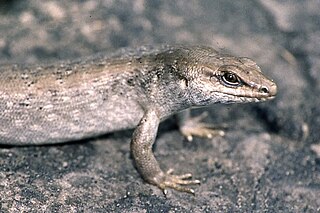
Leiolopisma is a genus of skinks. Most species occur in the region of New Caledonia-New Zealand, and they are related to other genera from that general area, such as Emoia; these and others form the Eugongylus group. One living and two extinct taxa represent a clade endemic to the Mascarenes.(Austin & Arnold 2006)

Blue-tongued skinks comprise the Australasian genus Tiliqua, which contains some of the largest members of the skink family (Scincidae). They are commonly called blue-tongued lizards or simply blue-tongues or blueys in Australia or panana in Indonesia. As suggested by these common names, a prominent characteristic of the genus is a large blue tongue that can be bared as bluff-warning to potential enemies. The type of predator/threat that is near will determine the intensity of colour present in the tongue. The tongue can also deform itself and produce a thick mucus in order to catch prey. They are relatively shy in comparison with other lizards, and also significantly slower due to their shorter legs.

The broad-billed parrot or raven parrot is a large extinct parrot in the family Psittaculidae. It was endemic to the Mascarene island of Mauritius. The species was first referred to as the "Indian raven" in Dutch ships' journals from 1598 onwards. Only a few brief contemporary descriptions and three depictions are known. It was first scientifically described from a subfossil mandible in 1866, but this was not linked to the old accounts until the rediscovery of a detailed 1601 sketch that matched both the subfossils and the accounts. It is unclear what other species it was most closely related to, but it has been classified as a member of the tribe Psittaculini, along with other Mascarene parrots. It had similarities with the Rodrigues parrot, and may have been closely related.

Round Island is an uninhabited islet 22.5 kilometres north of Mauritius. It has an area of 1.69 square kilometres and a maximum elevation of 280 metres. The island has been a nature reserve since 1957 and is administered jointly by the National Parks and Conservation Service and the Mauritian Wildlife Foundation. The island has been designated an Important Bird Area (IBA) by BirdLife International.

The hoopoe starling, also known as the Réunion starling or Bourbon crested starling, is a species of starling that lived on the Mascarene island of Réunion and became extinct in the 1850s. Its closest relatives were the also-extinct Rodrigues starling and Mauritius starling from nearby islands, and the three apparently originated in south-east Asia. The bird was first mentioned during the 17th century and was long thought to be related to the hoopoe, from which its name is derived. Some affinities have been proposed, but it was confirmed as a starling in a DNA study.
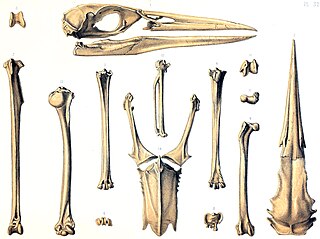
The Rodrigues night heron is an extinct species of heron that was endemic to the Mascarene island of Rodrigues in the Indian Ocean. The species was first mentioned as "bitterns" in two accounts from 1691–1693 and 1725–1726, and these were correlated with subfossil remains found and described in the latter part of the 19th century. The bones showed that the bird was a heron, first named Ardea megacephala in 1873, but moved to the night heron genus Nycticorax in 1879 after more remains were described. The specific name megacephala is Greek for "great-headed". Two related extinct species from the other Mascarene islands have also been identified from accounts and remains: the Mauritius night heron and the Réunion night heron.
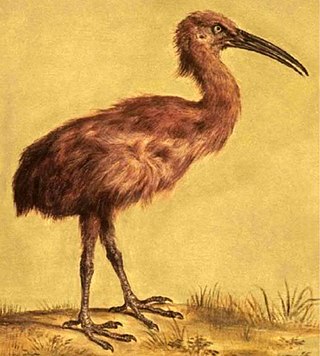
The red rail is an extinct species of rail that was endemic to the Mascarene island of Mauritius, east of Madagascar in the Indian Ocean. It had a close relative on Rodrigues island, the likewise extinct Rodrigues rail, with which it is sometimes considered congeneric, but their relationship with other rails is unclear. Rails often evolve flightlessness when adapting to isolated islands, free of mammalian predators, and that was also the case for this species. The red rail was a little larger than a chicken and had reddish, hairlike plumage, with dark legs and a long, curved beak. The wings were small, and its legs were slender for a bird of its size. It was similar to the Rodrigues rail, but was larger, and had proportionally shorter wings. It has been compared to a kiwi or a limpkin in appearance and behaviour.
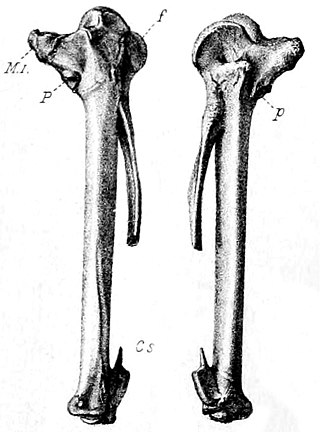
The Mauritius sheldgoose, also known as the Mauritius shelduck, is an extinct species of sheldgoose that was endemic to the island of Mauritius. While geese were mentioned by visitors to Mauritius in the 17th century, few details were provided by these accounts. In 1893, a carpometacarpus wing-bone and a pelvis from the Mare aux Songes swamp were used to name a new species of comb duck, Sarcidiornis mauritianus. These bones were connected to the contemporary accounts of geese and later determined to belong to a species related to the Egyptian goose and placed in the sheldgoose genus Alopochen. The Mauritius and Réunion sheldgoose may have descended from Egyptian geese that colonised the Mascarene islands.
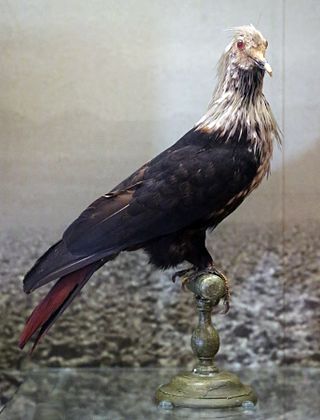
The Mauritius blue pigeon is an extinct species of blue pigeon formerly endemic to the Mascarene island of Mauritius in the Indian Ocean east of Madagascar. It has two extinct relatives from the Mascarenes and three extant ones from other islands. It is the type species of the genus of blue pigeons, Alectroenas. It had white hackles around the head, neck and breast and blue plumage on the body, and it was red on the tail and the bare parts of the head. These colours were thought similar to those of the Dutch flag, a resemblance reflected in its French common name, Pigeon Hollandais. The juveniles may have been partially green. It was 30 cm (12 in) long and larger and more robust than any other blue pigeon species. It fed on fruits, nuts, and molluscs, and was once widespread in the forests of Mauritius.
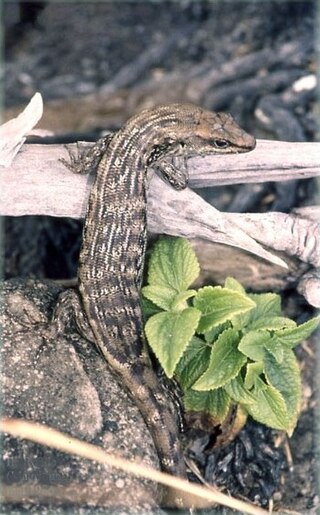
Leiolopisma telfairii, also known commonly as the Round Island ground skink, the Round Island skink, and Telfair's skink, is a species of lizard in the family Scincidae. The species is endemic to Round Island, one of the islands of Mauritius.

Gardiner's burrowing skink is a species of lizard in the family Scincidae. P. gardineri is the only species in the (monotypic) skink genus Pamelaescincus. The species is endemic to the Seychelles.

The saddle-backed Mauritius giant tortoise is an extinct species of giant tortoise in the family Testudinidae. It was endemic to Mauritius. The last records of this tortoise date to the early 18th century.

The domed Mauritius giant tortoise is an extinct species of giant tortoise. It was endemic to Mauritius.
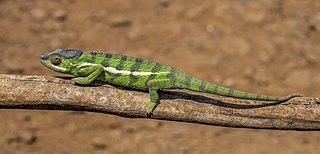
The wildlife of Réunion is composed of its flora, fauna and funga. Being a small island, it only has nine native species of mammals, but ninety-one species of birds.
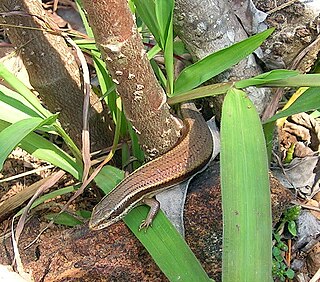
Lygosominae is the largest subfamily of skinks in the family Scincidae. The subfamily can be divided into a number of genus groups. If the rarely used taxonomic rank of infrafamily is employed, the genus groups would be designated as such, but such a move would require a formal description according to the ICZN standards.

The Cape Verde giant skink, also called Bibron's skink, Cocteau's skink, and lagarto in Cape Verdean Portuguese, is a recently extinct species of large lizard (skink) that was endemic to some of the Barlavento Islands of Cape Verde before disappearing in the 20th century.

Ile aux Aigrettes is an islet off the south-east coast of Mauritius. It functions as a nature reserve and a scientific research station. It is also a popular visitors attraction — both for tourists and for Mauritians.




















